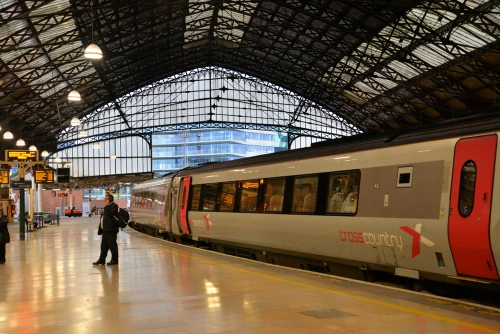
Europe’s longest train journey? Where to begin? Maybe what’s longer? Britain’s longest train journey, or Germany’s? So many questions.

On the one hand, Germany is quite a bit larger – its area is 70% more than Great Britain’s. On the other hand, Great Britain is a long, skinny island and Germany is much rounder – the distance from John O’Groats to Lands End is over 1,400km, but you never have to walk over 1,000km to cross Germany in any direction.
And it turns out these factors balance almost each other out. Britain’s longest train, the CrossCountry from Aberdeen in Scotland to Penzance in Cornwall, runs 785 miles or 1,263km. Germany’s longest train was the IC 2216 from Offenburg in the Black Forest to Greifswald on the Baltic coast, which was 1,300km. Though that route looks like it has now ceased operation, so the UK wins.
The UK
The Aberdeen to Penzance route isn’t really for people who want to go all the way across the country just to do Europe’s longest train journey. Instead, it’s a way to link together several railway lines and connect some medium-to-large cities that otherwise don’t have many direct services. “Cross-country” trains like these have existed for a century, but because they crossed multiple different company’s lines – and later, multiple British Rail regions – they tended to get ignored.
That’s why, when it privatised the railways, the government created a specific CrossCountry franchise so there was a company dedicated to these underused routes. If you want to get from Edinburgh to Leeds or Derby to Bristol, you’ll probably want a CrossCountry train.
The usual route is Edinburgh to Plymouth, but once a day they run an extra long one. Just one way though – there’s no Penzance to Aberdeen train.
Germany
The longest train in Germany was weird – at 1,400 km, it’s substantially longer than the country itself. On the map, the reason is obvious – it took a huge C-shaped route. (It also doubled back on itself at one point in order to reach Stuttgart).
This route took it down the Rhine, the biggest river in west Germany, and through the most densely populated patch of the country around Cologne and Dusseldorf known as the Ruhr. Germany’s second and third longest trains also have quite similar routes – they start and end in remote corners of the country, but all three have the Rhine-Ruhr metropolitan area in the middle.
[Read more: Europe’s night trains are under threat – and campaigners are moving to defend them]
You weren’t meant to take the IC 2216 all the way from north-east to south-west anyway – there are much more direct options available. Instead, it was for people who wanted to travel to these major cities. They could run two separate trains – say, Offenburg-Dusseldorf and Griefswald-Cologne – but making it a single route meant passengers benefited from a bit more flexibility.
France
France’s longest train exists for a very good reason. Most of France’s high-speed lines radiate out from Paris, and it’s very hard to get around the country without going to the capital. Usually, to get from Marseille on the Mediterranean to Nantes near the Atlantic, you’d need to take a TGV to Paris Gare de Lyon station, then get the Métro across the city to Gare Montparnasse.
Once a day though, this TGV avoids this faff by stopping in the suburb of Juvisy and turning around without going into the centre. This lets passengers travel direct between the coasts and reduces the traffic through Paris’s terminals during rush hour. The exact length of this route isn’t clear, but Wikipedia says it’s about 1,190km.
Spain
Spain’s longest train is very different. This is the Trenhotel sleeper service from Barcelona to Vigo, and it’s pretty fancy. This is a train for tourists and business travellers, with some quite luxurious sleeping cabins. But it is a regularly scheduled train run by the state operator Renfe, not a luxury charter, and it does appear in the timetables.
Being dry, hot and quite mountainous in its middle, most of Spain’s cities are on its coast (Madrid is the one major exception) and as a result, the train passes through relatively few urban areas. (Zaragoza, Spain’s fifth largest city, is on the route, but after that the next biggest city is Burgos, its 35th largest,)
This is partly why overnight trains work so well on the route – without many stops in the middle, most passengers can just sleep right through the journey, although there are occasional daytime trains on that route too if you want to savour the view on that 1,000km journey.
Italy
Finally, there’s Italy. This is another sleeper train, from Milan in the north to Syracuse on the island of Sicily. It goes via Rome and travels along the west coast of… wait, it’s a train to the island of Sicily? How, when there’s no bridge?
Well, this train takes a ferry. It’s just a train that they literally drive onto a ferry, sail across the water, and then drive off again at the other side.
Not the longest in Europe
Incredibly, the longest train in Europe doesn’t actually cross a single border. Unsurprisingly, it’s in Russia, but it’s not the Trans-Siberian – the vast majority of that route is in Asia, not Europe.
If you really want a long European train journey, head to Adler, just south of the Olympic host city Sochi. From there, you can catch a train up to Vorkuta on the edge of the Arctic Circle. The route zigzags a bit over its 89-hour, 4,200km journey, but it always stays on the European side of the Ural mountains.
[Read more: Why are trains in the UK so expensive?]






